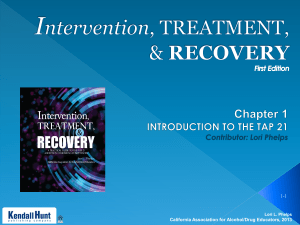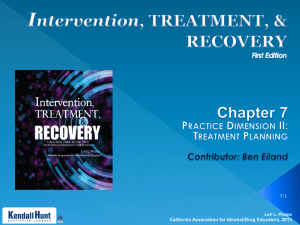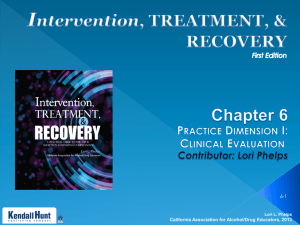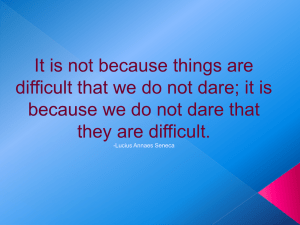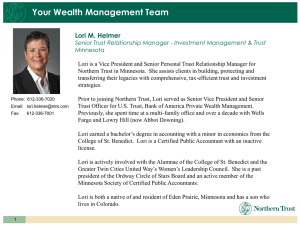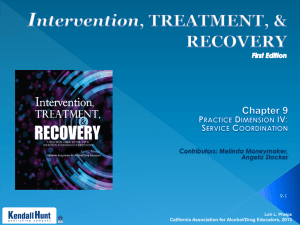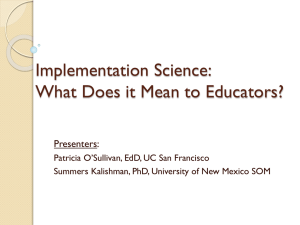Chapter 8 pptx - California Association for Alcohol/Drug Educators
advertisement
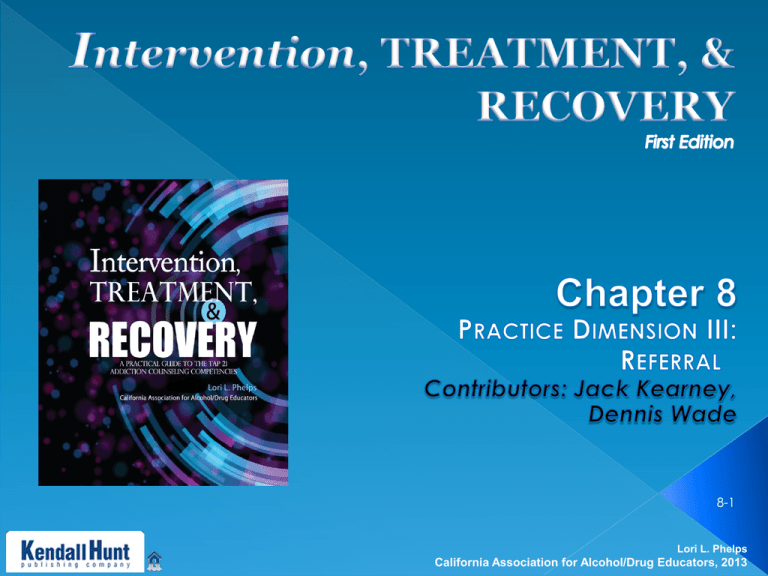
8-1 Lori L. Phelps California Association for Alcohol/Drug Educators, 2013 49: Establish and maintain relationships with civic groups, agencies, other professionals, governmental entities, and the community at large to ensure appropriate referrals, identify service gaps, expand community resources, and address unmet needs. 50: Continuously assess and evaluate referral sources to determine their appropriateness. 8-2 Lori L. Phelps California Association for Alcohol/Drug Educators, 2013 51: Differentiate between situations in which it is most appropriate for the client to self-refer to a resource and situations requiring counselor referral. 52: Arrange referrals to other professionals, agencies, community programs, or appropriate resources to meet the client needs. 8-3 Lori L. Phelps California Association for Alcohol/Drug Educators, 2013 53: Explain in clear and specific language the necessity for and process of referral to increase the likelihood of client understanding and followthrough. 54: Exchange relevant information with the agency or professional to whom the referral is being made in a manner consistent with confidentiality rules and regulations and generally accepted professional standards of care. 55: Evaluate the outcome of the referral. 8-4 Lori L. Phelps California Association for Alcohol/Drug Educators, 2013 City, county and state-operated vocational rehabilitation (VR) services; Public and private employment and job placement services; Public and private employers in the community; Vocational-technical colleges; Community colleges; Privately owned VR facilities; Criminal justice vocational training programs; Economic development centers(one-stop or workforce development centers); 8-5 Lori L. Phelps California Association for Alcohol/Drug Educators, 2013 Shelters for survivors of domestic violence; Mental health agencies; Homeless shelters; Child welfare agencies; Child care services; Family services; Housing authorities; Evening adult education programs; Alternative education programs; Literacy programs; Adult basic education programs and general equivalency diploma (GED) programs; 8-6 Lori L. Phelps California Association for Alcohol/Drug Educators, 2013 Young Men’s Christian Associations (YMCAs), Young Women’s Christian Associations (YWCAs), Young Men’s Hebrew Associations (YMHAs), and Young Women’s Hebrew Association (YWHAs); Social service organizations; HIV/AIDS programs; Independent living centers; Religious groups; Self-help meetings; Accessible meetings. 8-7 Lori L. Phelps California Association for Alcohol/Drug Educators, 2013 All collaborators, including those providing treatment for substance abuse disorders, should be aware that their efforts are likely to be ineffective unless all the client’s life areas are addressed. 8-8 Lori L. Phelps California Association for Alcohol/Drug Educators, 2013 An authentically connected referral network is composed of a set of defined relationships formed as clients’ needs dictate, using sound principles of case management and building in flexibility and adaptability to meet the needs of individual clients. 8-9 Lori L. Phelps California Association for Alcohol/Drug Educators, 2013 The authentically connected model calls for a communication mechanism that allows the timely dissemination of information to all agencies and stakeholders. An authentically connected network includes continually updated information about available resources. 8-10 Lori L. Phelps California Association for Alcohol/Drug Educators, 2013 Set priorities based on client populations in individual communities. Encourage responsiveness on the part of the community and the network as a whole, rather than from the agency only. 8-11 Lori L. Phelps California Association for Alcohol/Drug Educators, 2013 Client needs are the primary focus of the agencies’ existence. Emphasis is on shared purpose while acknowledging the organizational “cultures” among collaborating agencies. 8-12 Lori L. Phelps California Association for Alcohol/Drug Educators, 2013 Mutual provider credibility and trust are the core of the referral relationship. A sense of uniformity and cooperation is fostered by effective referrals. 8-13 Lori L. Phelps California Association for Alcohol/Drug Educators, 2013 Focus on identifying psychosocial issues and anticipating and helping the client obtain resources. Aim of case management is to provide least restrictive level of care necessary so client’s life is disrupted as little as possible. Case management must be flexible. 8-14 Lori L. Phelps California Association for Alcohol/Drug Educators, 2013 Assess Client For: Ability to obtain and follow through on medical services; Ability to apply for benefits; Ability to obtain and maintain safe housing; Skill in using social service agencies; Skill in accessing mental health and substance abuse treatment services. 8-15 Lori L. Phelps California Association for Alcohol/Drug Educators, 2013 Explain to clients and significant others that: › Addiction is a treatable chronic disease. › You want to give them the best treatment and so you are referring them to a specialist much like you would do for other chronic diseases. › When stabilized, patients may return to the primary care provider for ongoing care. 8-16 Lori L. Phelps California Association for Alcohol/Drug Educators, 2013 “Ask-Tell-Ask” Approach: 1. Ask permission to discuss something with them. 2. Tell them your concerns. 3. Ask what they thought about what you said. 8-17 Lori L. Phelps California Association for Alcohol/Drug Educators, 2013 Explain that you need to discuss drug use because you are concerned about their health and why you are recommending a referral. Point out the direct relationship between their drug use and any health or social consequences they might have experienced. Provide as much information as possible about the provider/clinic where you are referring the client. Maintain client’s privacy. 8-18 Lori L. Phelps California Association for Alcohol/Drug Educators, 2013 Referral of a patient is called for if the care is beyond the scope of your own training or if the necessary care cannot be provided. Note: Consent of client must be obtained before the release of confidential information to any third party. Release of information to non-health care workers requires the full written consent of the client(with limited exceptions). 8-19 Lori L. Phelps California Association for Alcohol/Drug Educators, 2013 Referral Forms: › Who – Identify the client and counselor who made the referral. › What – Types of issues that led to referral. › How – Describe consequence of referral or how client was dealt with. 8-20 Lori L. Phelps California Association for Alcohol/Drug Educators, 2013 a. b. c. d. e. f. g. h. i. Referrals may be made to a range of community services and resources. 12-step program is the first referral. Alcohol and other drug treatment and rehabilitation services. Counselors, psychiatrists, psychologists, and social workers in private practice. Community mental health facilities. Community social service and welfare agencies. Hospital outpatient departments. Community public school systems. Court and probation systems. 8-21 Lori L. Phelps California Association for Alcohol/Drug Educators, 2013 a. b. c. d. e. f. g. h. The program’s record and success rate. Attitudes of program staff. Education and training of program staff. Licensure and accreditation of the program. Treatment of alcohol and drug dependence as primary disorders. Patients free of drugs early in the recovery process. Adequate provision for care of acute medical problems. Extent to which the program will help expedite the 8-22 client’s entry into treatment. Lori L. Phelps California Association for Alcohol/Drug Educators, 2013 i. j. k. l. m. n. Use of a comprehensive treatment approach. Encouragement of families to participate in the treatment process. Active preparation of clients against relapse. Development of a plan of continuing care. Ability to respond to special issues and needs. Reasonable cost. 8-23 Lori L. Phelps California Association for Alcohol/Drug Educators, 2013 a. b. c. d. e. Give rationale for referral. Describe the referral resource. Provide emotional and logistical support. Provide name and number of contact person. Discuss monitoring and follow-up plans. 8-24 Lori L. Phelps California Association for Alcohol/Drug Educators, 2013 A. B. Treatment Planning and Use of Referral Network by Stage of Illness. Importance of Follow-up and Monitoring. 1. 2. 3. C. D. Client may find referral unsatisfactory and require new referral. Client may drop out of specialized treatment and need help in returning. Referral of family and significant others to support groups. Managing Treatment Problems Posed by Concurrent Treatment Modalities. Discharging Clients Before Completion of Program. 1. Make a reasonable effort to place in a suitable program. 8-25 Lori L. Phelps California Association for Alcohol/Drug Educators, 2013 1. 2. 3. 4. 5. Determine the services available in the local area by developing an updated inventory and by resource mapping. Hold discussions with agencies identified as potential collaborators. Develop working agreements between collaborators to organize information sharing and communicate respective roles. Determine the agency’s criteria for accepting clients. If warranted, establish a partnership with the agency and draft agreements regarding the flow of information and feedback between the agencies to ensure provider 8-26 accountability. Lori L. Phelps California Association for Alcohol/Drug Educators, 2013 o Multiple agencies work as equal partners with each other and with the client. Referring agencies make the initial contact to the referral source and keep abreast of client progress. o Clients and agencies have mutual responsibility and trust. Interagency accountability and data sharing exists. o Communication mechanisms for timely information dissemination are accessible to all agencies and stakeholders. 8-27 Lori L. Phelps California Association for Alcohol/Drug Educators, 2013 o The full range of stakeholders is identified, including local community services, and feedback is elicited from all of them. o Relationships among providers are collaborative and flexible in the assumption of multiple job tasks related to client needs. o The network is client, vision and mission driven. o Change and growth of the referring organization are demonstrated as a result of the referral process. 8-28 Lori L. Phelps California Association for Alcohol/Drug Educators, 2013 o The network is open to new paradigms, approaches, use of technology on behalf of clients, and individualization of client treatment plans and services. o There is ongoing provider training and involvement in continuing education and staff development. o Shared assessment of network effectiveness is ongoing. o Cross-training of staff among collaborating agencies is ongoing. 8-29 Lori L. Phelps California Association for Alcohol/Drug Educators, 2013 o Accountability is results and progress based, with interagency negotiation of shared outcomes. o The referral process is concurrent. 8-30 Lori L. Phelps California Association for Alcohol/Drug Educators, 2013 Performance Assessment Rubrics for the Addiction Counseling Competencies: http://www.nattc.org/regcenters/index_nort hwestfrontier.asp 8-31 Lori L. Phelps California Association for Alcohol/Drug Educators, 2013 Self-Assessment of Your Skills With Competencies Go to the Performance Assessment Rubrics for Addiction Counseling Competencies and asses your skills with competencies 49-55. Assess Community Resources Practice assessing referral needs and referral resources in your community. Identify Community Resources Make a list of substance abuse, mental health, and other relevant resources in your community. 8-32 Lori L. Phelps California Association for Alcohol/Drug Educators, 2013
